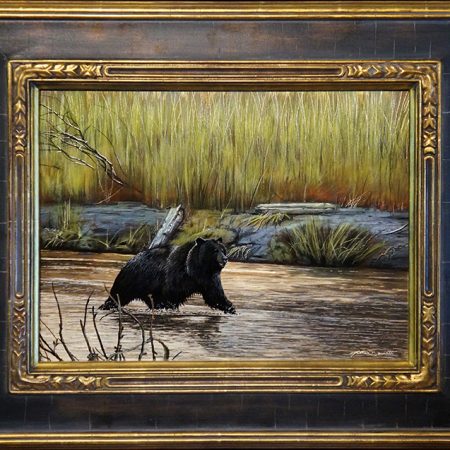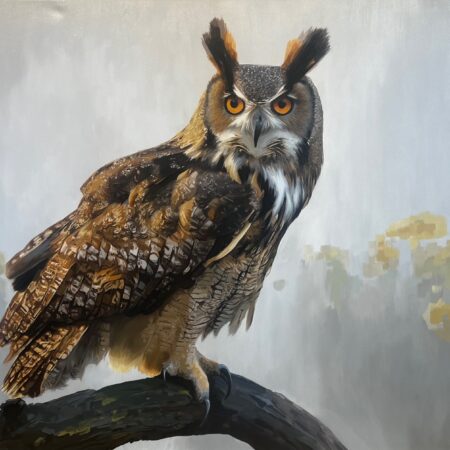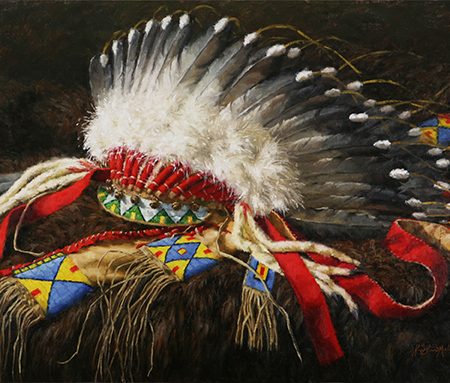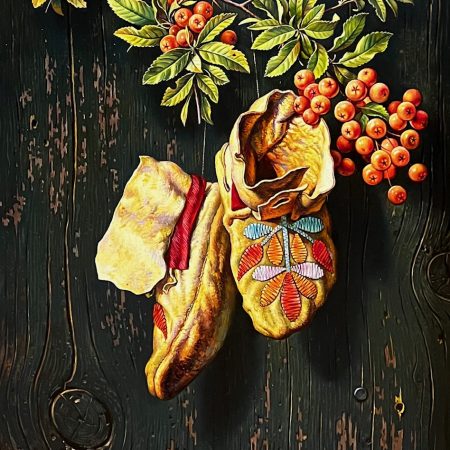Nathan Bennett
When most people visualize the Statue of Liberty, its blue-green appearance is usually the first characteristic that comes to mind. The color comes from the natural patina process that occurs over time with changes in temperature and exposure to moisture on the statue’s copper surface. Although patina can naturally occur, the deliberate act of applying it remains an ancient technique, and one of the most secretive art forms today. Ancient Egyptians would patina their sculptures to create shades of red, blue, green and gold, and today, Utah artist, Nathan Bennett introduces this process on two dimensional pieces of bronze, resulting in complex patina paintings.
Nathan Bennett describes the method as “using different metals and applying them through the use of fire and various chemicals to create colors on bronze.” The technique is just as complicated and as messy as it sounds, and it requires a great deal of patience and time to master. Bennett’s interest in art stemmed from a young age, received two university scholarships right out of high school to pursue his dreams. However, during a period of pain and confusion at the age of 18 Bennett was told, “take time to find yourself” and it was then that he found patina and his gift in mastering the art.
While discussing the process with the artist, one can hardly believe that Bennett doesn’t have a solid background in science and alchemy, considering the immense technical terminology and understanding that patina requires, but trial and error led him to create the most vibrant colors and beautiful images.
Even for those who are not aware of the complex patina process, Nathan Bennett’s art proves to be nothing short of compelling. Take his pieces “Four Seasons” for example; all four sides of the bronze sculpture are painted with the image of each season, but they are not the seasons of the earth. Rather, they represent the seasons of our lives. Bennett explains that, “we all have season, some quick to burn, some mark significant changes, but they all shape who we are in the end.”
One element that distinguishes Nathan Bennett’s work from all the others is his use of trees. “Trees are a symbol of us,” he states. Bennett found that he could convey the human emotion through the use of a tree more clearly than any other symbol. These tress are usually black or gold, silhouettes that breathe against a dreamlike mist of color. Although the trees tend to be portrayed as shady images, the magic in Bennett’s work comes with the realization of what creates that shadow. Take a close look at Nathan Bennett’s art; you’ll notice that, although the darker images tend to make you feel a certain way, once your eyes catch the light of the colors, the feelings seem to lift. “You can’t see the light without the dark,” Nathan continues, “mostly what I paint it is hope.”
Using the patina process on bronze plates as his canvas, Nathan Bennett mines new veins in painting. His landscapes have a surreal quality, a sense of otherness, which is partly due to his unusual medium. Taking the chemicals normally used to finish bronze sculptures- the oxides, nitrates and acids- Bennett instead wield them as he would pain on an eighth-inch-thick sheet of silica bronze that becomes his canvas. The work itself is stark, haunting almost, in its barrenness. His landscapes startle. Without relying too much on the materials themselves for effect. Bennett realizes nature in cold hard metal, light in acidity and a kind of esthetic spirituality born of poetic austerity. “I feel that in order to understand my art, knowing a bit of its history is important. Alchemy started in the first century A.D. As time passed, the predominant goal of alchemists was to transmute basic metals into gold. This was done in great secrecy. Finding such a thing would bring the unimaginable wealth and power. When religion started to play in Alchemy, it took on a spiritual journey. Heaven and eternal life became the goal. All of the endeavors now play a big role in many facets of life as we know it. Alchemists used their intimate knowledge of metals to adorn sculpture with what is now referred to as patina, and the patineur was born. During the centuries that followed, patinas stayed very basic; copper, sulfur and ferric were applied using fire. In 1989, I made a clear and calculate decision to turn the art of patina back into alchemy. Soon after, my hot process patina paintings took their first breath. In the true spirit of alchemy, and with basic metals, I sought not for wealth, transmutation the metals into gold, but to manipulate them into a one of a kind work of art. Using fire and metal, my spirituality was visualized, connecting me to heaven and God. Through hot process patina painting, I feel that I have found my eternal elixir. In a way, I will live forever in my art.”






























































